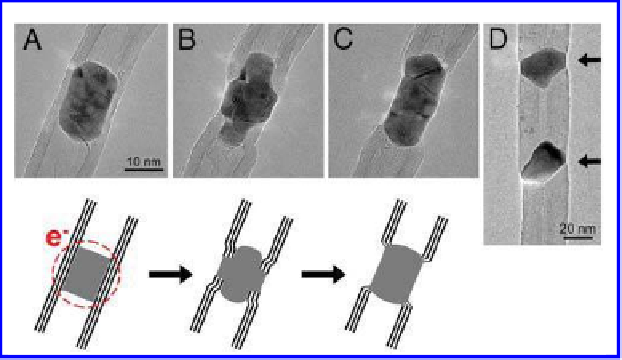Biomedical Engineering Reference
In-Depth Information
9.2.6.3
Juncons between CNTs or between metals and CNTs
Through different procedures, it is possible to obtain heterojunctions
between CNTs and different metal nanocrystals m (Fe, Co, Ni and FeCo)
(Fig. 9.25).
161
The heterojunctions are formed from metal-illed MWCNTs
via intense electron-beam irradiation at temperatures in the range of 450-
700°C, while real-time
in situ
imaging could be carried out. The time required
to obtain the inal heterojunction was 11 minutes. DFT calculations predicted
that these structures are mechanically strong, the bonding at the interface is
covalent (directional) and the electronic states at and around the Fermi level
are delocalised across the entire system. This conirms the metallic nature
of the heterostructure, thus promoting the generation of these MWCNT-
m
-
MWCNT junctions (where
m
is the metal particle) with promising transport
properties for robust nanotube-metal composite materials.
Figure 9.25
Formation of a MWCNT-
m
-MWCNT junction from a magnetic-particle-
illed MWCNT subjected to electron irradiation (200 keV) at 700°C. (A) Beginning of
the experiment. (B) The focused electron beam damages the tube, and the
m
nanowire
is expelled to the surface, experiencing shape changes after 6 minutes of irradiation.
(C) Finally, the
m
(Co) particle acts as a link between the two MWCNT segments. The
sketch at the bottom shows the mechanism of the process. The circle indicates the
zone subjected to electron irradiation. Reproduced from Rodriguez-Manzo
et al
.
161
with permission.
A further development of this study was the elaboration of Y junctions
through analogous electron-beam irradiation of SWCNTs at high
temperatures.
162
To achieve such shape, a merging process of asymmetric into
symmetric rings using CNTs was applied and conirmed by TEM. On the basis
of such results, many diversiied structures of interferometers with deined
ring symmetries could be envisaged.


Search WWH ::

Custom Search